 |
 |
 |
 |
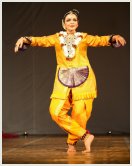 |
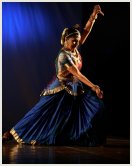 |
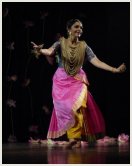 |
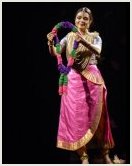 |
 |
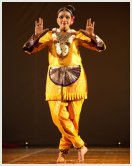 |
|
Home | Credits | Press | Response | Photo Gallery | Calendar of Performances
Neelam
- of skies, seas and the in-betweens…of the masculine, the feminine and
the in-betweens…
By Aniruddhan Vasudevan Contemporary performance works, with their heightened demand on the readers/audience to consciously engage and interpret, often leave a reader wondering how much can be read into a work, where one has to stop, and when it becomes too much. But, I guess, these are of peripheral importance and arise, primarily, due to being used to not really having to interpret or make an effort to understand. What really matters is the process of engaging with a work itself, not being quick to pronounce something as being abstruse, untraditional, modern, etc. Anita Ratnam's latest work, 'NEELAM - drowning in bliss' feels like a work of fine artistic unity effected by symbolic evocations of colour, gestures, movements, lighting and music. A journey through the androgynous dance of Nambi, the erotic cajoling of Aandal to Panchajanya, Krishna's heart-rending surrender to Radha, and montages of the Ramayana - traverse a vast ground between the individual and the epic; between masculine valour, female sexuality, and androgyny; between the Alwars, Andal, Jayadeva and Muthuswami Dikshitar. Anita, who had conceived and choreographed the work, had Hari Krishnan (inDance, Canada) for her choreographic consultant. This reviewer watched her performance during the new LEGENDS OF DANCE morning session at the Music Academy on January 5, 2007. That Anita was programmed along with Vyjayantimala, Dhananjeyans and Lakshmi Viswanathan was a tribute to her unswerving zeal for dance and modernity with an Indian aesthetic. The first part, SRIMAL - the Dance of Nambi, visually explored the notions of a complete self being a singular composite of both the masculine and feminine, as represented by the androgynous dance of Nambi, an indigenous, Tamil version of Vishnu. Not only did this posit a refreshing alternative to the much-abused iconic androgynous representation of Ardhanareeswara, but also, by the use of Nammazhwar's Tirukkurungudi pasuram, suggested a possible shift of perspective of his poetics from the sweep-under-carpet bridal mysticism to subtle and lyrical homoeroticism. Personally, I think, it will take this reviewer a while to come to get a grasp at Anita's consistent preoccupation, in most of her works, with mandalas, spaces - sacred or otherwise. But he cannot help but look at it primarily as a metaphor to the idea of carving one's spaces. And the slowly collapsing circumscribing use of space by Anita (in SRIMAL) did remind one of the Irish poet W B Yeats' understanding and use of the term "gyre." The brilliant costume for this piece, designed by Rex, consisted of a kurti-like top and capri-like trousers in a liminal shade between mustard and mango, and hence both and neither at once. While my mind rejoiced at the deft use of cuts that resembled those of unisex clothing that are ubiquitous these days, it could also notice with great delight the costume's evocation of the Angis that adorn Utsava Moorti-s in Vaishnava temples, on specific festive occasions! Bharatanatyam adavus and gestures from the Arayar Sevai ritual tradition were used discretely with no naďve attempt at fusion. Kodhai's (Aandal) monologue to the holy conch, Panchajanya, seems to progress through the well-known pattern of sama-bheda-dana-danda, from cajoling through bullying! The shift from the sthayi-based abstraction of the previous piece to the padhartha abhinaya (word-by-word delineation) of this piece was sharp and very effective. Also, Anita chose to use a corner spot, distinctly different and away from the enclosed space she had charted in her dance of Nambi. The legend of Krishna himself completing the lines suggesting his surrender at the feet of Radha in the Ashtapadi beginning "Priye Charusheele," is a well-known one. This baggage sometimes weighs so heavily on this beautiful piece that usually in concerts where it is performed, the audience's impatience for the dancer to come to the lines "mama shirasi mandanam" is almost palpable! But here, that was neatly avoided. Though it was OS Arun's soulful rendition of the ashtapadi in vaasanthi raagam that pinned down attention at the outset, soon one felt its flowery and emotion-loaded nature was a sudden leap from the kind of music and the general starkness one had found in the previous numbers. Anita's absolutely minimalist use of a single diagonal, the attendant lighting and the subdued abhinaya - all offset this seeming incongruity to a considerable extent. A special word of appreciation for Hari Krishnan and Rex whose lighting design very poignantly suggested the addressee, Radha, seated in disturbing silence in a corner. Muthuswami Dikshitar's "Rangapura Vihara…" in Brindavana Saranga, again, has a distinctive place in the cultural contours of Carnatic music and Bharatanatyam, considerably due to Smt. M S Subbulakshmi's riveting rendition of it. The centre spot came alive on a garland laid on the stage, forming an enclosed space, for a duration that was enough to suggest in an epiphanic flash, the small island of Srirangam. But, even before one noticed it, the garland had become the one that Aandal adorned herself with before her Lord could. Anita also immediately prevented one from beginning to see it as a garland and garland only; it went on to suggest a myriad things, from the giant entrance to the Srirangam temple, to Rama's bow, Krishna's flute, Hiranyakashipu's guts in the hands of Narasimha, Balarama's plough, Kalki's whip, and more. The Ramayana montages that Anita sketched as small friezes were made more interesting by Rex's lighting, with his effecting a delay in erasing the previous still while Anita had already moved on to the next. It thus created an art gallery feel as well. The master stroke, according to this reviewer, was when Anita used the garland-enclosed space as Seeta's 'safe' space charted out for her. It suggested not only the restrictive and claustrophobic nature of that space, but also the fact that forces other than her self (call it patriarchy, call it what you may) have decided that space for her and, what's more, with a threat of punishment for stepping out, quite literally! KSR Anirudha's excellent music design and jathi composition for SRIMAL - the dance of Nambi-Vishnu provided the platform for Revathy Sankkaran's and Pradeep Chakravarthy's voices to weave the Nambi Kavuthvam and the chant respectively. Sikkil Gurucharan's clear, soulful rendition of the Alwar pasuram and, later, Brindavana Saranga ragam and "Ranga Pura Vihara," to the soundscape conceived by Anil Srinivasan, was a major base. In summing up, this reviewer would say that NEELAM represents a significant turning point in solo performances by a mature practitioner. In the confusing conundrum of modernity, Anita Ratnam's performance and articulation established a confident and honest clarity in word and action. A brilliant showcase of dance, theatre, music, lighting and visual design. This article appeared in the dance quarterly NARTANAM, Volume 7, Jan to Mar 2007. |